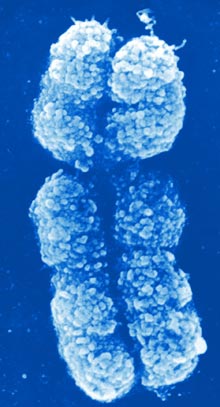
Image: Indigo Instruments
In a recent post called, "Autoimmunity and Gender", we mentioned that one reason women are more prone to autoimmune disorders, or those conditions where the body's immune system attacks its own cells, is because of chromosomal influence, but we didn't elaborate. If you're guessing that it has something to do with the sex chromosomes, the X and Y, you are totally correct...but it may not be for the reason you think. It is not merely the presence of the two X chromosomes in genetic females that leads to autoimmune disorders, but the way the body handles them.
Genetic females have two X chromosomes while genetic males have one X and one Y, so females have twice as many X genes as males, right? Wrong! The X chromosome is incredibly rich in genes that are then made into proteins, while the Y has significantly fewer important genes. Fortunately, the body recognizes this potentially harmful difference in gene number and corrects the problem by a process called X-chromosome inactivation. In this process, every cell in the body chooses one X chromosome, either the one inherited from the mother or the one from the father, to make inactive. That DNA in that chosen chromosome is then wound up very very tightly to form what is called a barr body. Because it is wound up so very tightly (a formation called heterochromatin), the genes from the barr body can not be made into proteins, so it is considered inactive.
If genetic females have one active X chromosome, and so do males, how does this influence the risk of autoimmune disorders? Well, remember that every cell chooses which X chromosome to inactivate and that they do this independently of each other. One heart cell may inactive the X chromosome from the mother, while another right beside it inactivates the X chromosome inherited from the father. This makes all genetic females a type of genetic mosaic: our cells can express two different sets of chromosomes depending on which X chromosome is inactivated.

Image: Haane-Mugaas.com
Getting to the point, think about immune cells: they're these destroyer cells whose sole mission is to hunt down and kill any cells that don't match their DNA code. Usually, this is a good way to target the bacteria and viruses that don't belong, but the immune cells can also get a little too good at their job. If an immune cell that has inactivated the maternal X chromosome meets a nerve cell that has inactivated the paternal X chromosome, that immune cell could be triggerred to destroy the "invader." That, in the end, is how having two X chromosomes can lead to increased risk of autoimmune disorders in genetic females.
PS- Why the picture of the calico cat? Besides the fact that cats rule, fur color is also X linked and depends on X chromosome inactivation. One fur cell decides to inactivate the maternal X carrying orange color, so that cell (and all the cells that come from it) are black or white. Nearby, the opposite happens and you get a patch of orange fur from Mom's X chromosome staying active. It's science in action!
For more information:

Comments